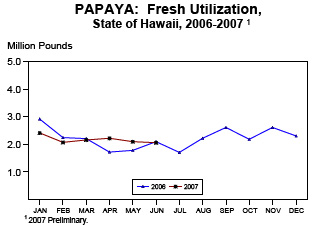The Hot Seat
The Honolulu Advertiser
From politicians to newsmakers to everyday people in the news ? Editorial and Opinion Editor Jeanne Mariani-Belding puts them in the Hot Seat, and lets you ask the questions. So get ready. Let the conversation begin.
Reach Jeanne at jmbelding@honoluluadvertiser.com.
Posted on: July 30, 2007 at 12:02:58 pm
Now on the Hot Seat: Maui Land & Pineapple Co.?s CEO David Cole
Welcome to The Hot Seat! Joining me today is Maui Land & Pineapple Co.?s chairman, president and CEO David Cole.
The closure Maui Land and Pineapple?s canning operation in June marked the end of an era; it was the last canning operation of its kind in the United States. And, as David notes in his commentary in Sunday?s Advertiser, it was also a rite a passage for so many of us here in Hawaii.
David joins us live and will take your questions on his company and the future of agriculture in Hawaii.
With that, let?s chat.
[first question]
Christopher: Can you please explain why Maui Land and Pineapple continues to be a member of the LURF Foundation? Maui Land and Pineapple purports to hold the values of “malama ‘aina, ecology and creating holistic communities.”
With these guiding principles, I have difficulty seeing the association with LURF, which has quietly lobbied against most of the grassroots sustainability issues that have ever come up.
Perhaps with your company’s leadership, you could take LURF in a more modern 21st-century direction?
David Cole: The Land Use Research Foundation has been around since the late ’70s. In recent years, LURF’s focus has become more development-related, although the organization also works with other organizations, such as the Urban Land Institute, Hawai’i Economic Association and the Hawai’i Farm Bureau Federation. One of the goals of LURF is to protect the rights of landowners who are also developers.
As we understand it, LURF has not lobbied, quietly or otherwise, against sustainability issues. In fact, LURF Executive Director David Arakawa has taken a position that is very supportive of sustainability initiatives.
If this not the case, perhaps we should be more engaged in a leadership mode and concentrate more effort another organization?
[last question]
IslandBiz: Aloha, David. I want to say thanks for doing the Hot Seat and talking story with us. I read the article on you recently in Hawaii Business.
Tell us one thing about you that has not been written about that might be surprising, something that would give insight into what kind of a guy you are. Make it a good one!
David Cole: Greetings Islandbiz. My campaign poster for VP of the Associated Students of the University of Hawaii (ASUH) back in the 70’s showed me naked on horseback with the slogan “nothing to hide.”
There you have it!!
CLICK HERE to view the full “Hot Seat” conversation
 JUNE FRESH PAPAYA OUTPUT LOWER
JUNE FRESH PAPAYA OUTPUT LOWER To restore Molokai’s contaminated soil, University of Hawaii researchers Alton Arakaki and Qing Li, as well as retired Molokai farmer Lonnie Williams, are rooting for a technique called phytoremediation, which consists of growing plants that can naturally accumulate chemicals from soil.
To restore Molokai’s contaminated soil, University of Hawaii researchers Alton Arakaki and Qing Li, as well as retired Molokai farmer Lonnie Williams, are rooting for a technique called phytoremediation, which consists of growing plants that can naturally accumulate chemicals from soil.